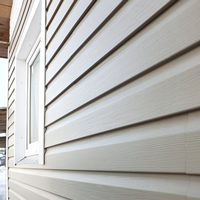Vinyl Siding
 A durable and long-lasting material, vinyl siding requires little maintenance other than a good washing to keep it looking fresh. Vinyl siding is generally less expensive than most other types of siding, but unless it’s of good quality may fade over time. Made from PVC, vinyl siding has been around since the early 1960s, and as of the 2013 census, it is the most commonly used siding in new, single-family homes.
A durable and long-lasting material, vinyl siding requires little maintenance other than a good washing to keep it looking fresh. Vinyl siding is generally less expensive than most other types of siding, but unless it’s of good quality may fade over time. Made from PVC, vinyl siding has been around since the early 1960s, and as of the 2013 census, it is the most commonly used siding in new, single-family homes.
 With advancements in the technology of manufacturing, the last decade has seen amazing strides in vinyl siding production, creating a “resurgence of interest.” Careful design and engineering have produced vinyl siding that can perfectly mimic the look of many types of cladding and architectural accents, including wood, stone, and slate. In addition, current vinyl siding has improved strength and weather resistance and comes in a broader selection of factory colors.
With advancements in the technology of manufacturing, the last decade has seen amazing strides in vinyl siding production, creating a “resurgence of interest.” Careful design and engineering have produced vinyl siding that can perfectly mimic the look of many types of cladding and architectural accents, including wood, stone, and slate. In addition, current vinyl siding has improved strength and weather resistance and comes in a broader selection of factory colors.
CertainTeed Monogram® 46 Premium Vinyl Siding
Insulated Siding
 Insulated siding is a vinyl product with the added benefit of insulation. It’s usually just included in the vinyl siding category, however, the difference is that it has the insulation glued inside— the insulation is made to fit the profile of the vinyl siding, and the two are bonded together. Another type of insulated siding has a similar backing, but the foam core, though still manufactured to fit the shape of the siding, is left unbonded as a separate piece. Expanded polystyrene (EPS) is the most common insulation material used in insulated siding.
Insulated siding is a vinyl product with the added benefit of insulation. It’s usually just included in the vinyl siding category, however, the difference is that it has the insulation glued inside— the insulation is made to fit the profile of the vinyl siding, and the two are bonded together. Another type of insulated siding has a similar backing, but the foam core, though still manufactured to fit the shape of the siding, is left unbonded as a separate piece. Expanded polystyrene (EPS) is the most common insulation material used in insulated siding.
Since its inception in the late 1990s, insulated siding has gained significant recognition for providing increased energy efficiency due to its ability to counteract the “thermal bridging” effect in homes. Thermal bridging occurs where the interior and exterior of a home are connected, or bridged, by a poorly insulating material; an example of this kind of bridge would be the wall studs that interrupt the insulated stretches of a wall and allow heat to flow between the home’s interior and the outdoors. Using insulated siding helps erect a barrier to prevent heat loss (or gain) at the points where the studs contact the outer wall of the house and at other areas where thermal bridging commonly occurs.
Vinyl Shutters
 Vinyl Shutters can add value and beauty to your home. No matter what your budget, you will find that this simple home repair can give your home big impact and value.
Vinyl Shutters can add value and beauty to your home. No matter what your budget, you will find that this simple home repair can give your home big impact and value.
We know your house is your most important asset, so to help you to improve or to preserve the value of your home we offer a wide range of styles, sizes and colors of decorative exterior vinyl shutters. Putting exterior shutters on the outside of your home is dollar per dollar the most cost effective home makeover with the most dramatic effect.
Whether you are keeping or selling your home, using custom exterior vinyl shutters as window accents will instantly add “curb appeal” and brighten your whole neighborhood. Custom vinyl exterior shutters add a whole new look to the outside of your windows that you will enjoy for years to come.
Vinyl Soffit
Vinyl Soffit protects the underside of your roof. It provides ventilation that prevents heat build-up and humidity from damaging your attic. You can also add soffit to the underside of staircases, cornices and beams to protect those areas from water damage.
Fascia
Fascia is the vertical covering that connects the roof to the soffit. It’s the finished edge of the roof, to which gutters are attached. On a residential home, the fascia is usually built of aluminum or wood. Fascia can be painted to create an appealing contrast to roof and siding colors.
Gutters
Gutters protect your foundation from water damage by funneling any rain or snowmelt from the sides of your home. Without gutters, water would run down the exterior walls and pool around your home, leading to compromised foundations and leaky basements.
[/callout]
